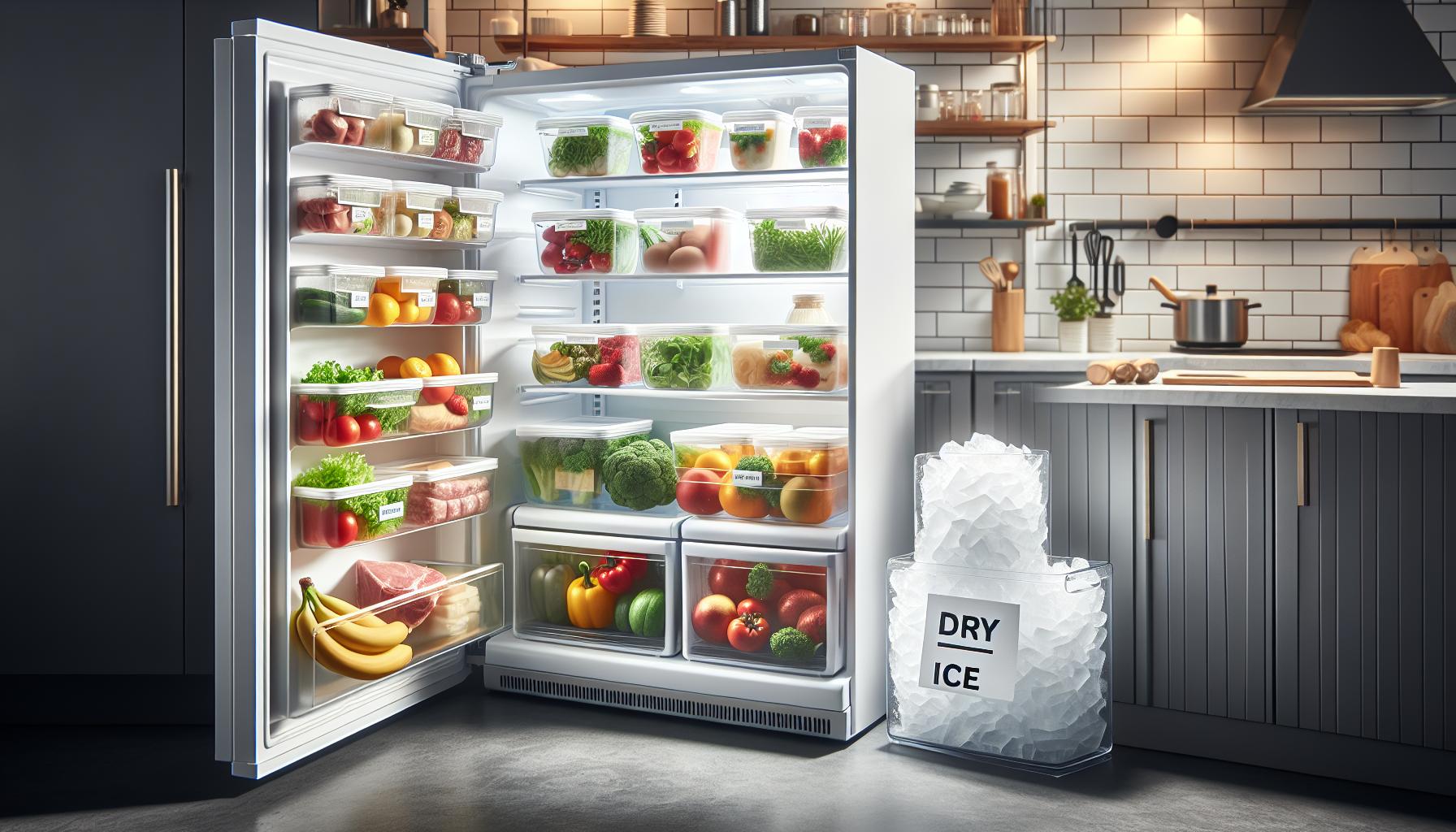Dry ice is a powerful cooling agent, ideal for preserving food items and maintaining freshness during transport. However, understanding how long dry ice lasts in a freezer is crucial for effective use. Many people wonder how to maximize its cooling power without risking spoilage or waste.
Inadequate knowledge about dry ice can lead to unnecessary food spoilage and safety concerns, especially during long trips or power outages. By learning proper storage guidelines and timeframes, you can not only extend the life of your dry ice but also ensure your perishable items remain intact.
Curious about how to optimize your dry ice usage? Read on to discover practical tips and insights that will help you make informed decisions while keeping your food safe and cool.
How Dry Ice Works for Cooling Solutions
The cooling power of dry ice is a fascinating phenomenon rooted in the science of sublimation. Unlike regular ice, which melts into water as it absorbs heat, dry ice sublimates directly from a solid to a gas at temperatures below -78.5°C (-109.3°F). This unique property makes dry ice an incredibly efficient refrigerant, ideal for various applications, especially in food preservation and shipping. When placed in an insulated environment, such as a cooler or freezer, dry ice actively absorbs heat from its surroundings, keeping the interior at lower temperatures without introducing moisture, which can be a concern with conventional ice.
To maximize the effectiveness of dry ice, understanding its placement and usage is crucial. When loading dry ice into a cooler, it’s most effective to layer it on top of items that need to stay frozen, as cold air descends. For optimal cooling, ensure that the cooler is well-insulated and minimize openings to reduce heat entry. Additionally, consider the volume of dry ice relative to the space you need to keep cool: roughly 5 to 10 pounds of dry ice can adequately chill a small cooler for 24 to 36 hours, depending on the ambient temperature and insulation quality.
Here are some practical considerations for working with dry ice:
- Safety First: Always handle dry ice with gloves or tongs to avoid skin burns.
- Avoid Sealing: Never seal dry ice in a container; it needs to sublimate and release gas to prevent pressure build-up.
- Ventilation: Store dry ice in a well-ventilated space to avoid the accumulation of carbon dioxide gas.
By leveraging these properties and handling tips, dry ice can serve as an excellent cooling solution, ensuring your perishable items stay safe and fresh longer during transport or storage.
Factors Affecting Dry Ice Longevity in Freezers
The longevity of dry ice in freezers is influenced by several critical factors that dictate how effectively it can preserve the low temperatures necessary for food and other perishables. Understanding these factors allows users to maximize the cooling power of dry ice and ensure that their items stay safely frozen for as long as possible.
First and foremost, the storage environment plays a pivotal role. A well-insulated freezer will retain cold much better than one with poor insulation. If the freezer frequently opens or has a lot of warm items added, the internal temperature can fluctuate, causing the dry ice to sublimate more quickly. An optimal storage temperature of around -18°C (0°F) or lower is ideal for prolonging dry ice life. Additionally, maintaining a stable environment without excessive light or heat sources will help in minimizing sublimation.
Another significant factor is the form and amount of dry ice being used. Larger blocks of dry ice will generally last longer than smaller pellets or shavings, as they sublimate at a slower rate due to their mass. It’s recommended to use dry ice in sizes that match your cooling needs; for example, a piece weighing about 10 pounds can last 24-36 hours in a properly maintained freezer. Using dry ice in conjunction with other cooling methods, such as frozen gel packs or traditional ice, can further extend the period items remain frozen.
Finally, proximity to other items also impacts dry ice longevity. Placing dry ice directly in contact with items needing freezing can lead to temperature consistency but can also drive faster sublimation as the ice absorbs heat directly. Instead, creating a buffer using insulated barriers or placing dry ice on top of less temperature-sensitive items can help prolong its life.
By addressing these factors-insulation quality, the form and amount of dry ice, and strategic placement within the freezer-you can significantly maximize the duration that dry ice remains effective for cooling, ensuring your perishables stay secure and fresh longer.
Ideal Storage Conditions for Maximum Dry Ice Life
To optimize the life of dry ice in your freezer, it’s crucial to consider a few key storage conditions. One of the foremost factors is maintaining an ideal temperature. Keeping the freezer at -18°C (0°F) or lower creates a stable environment that slows down the sublimation process, thereby extending the duration that the dry ice remains effective for cooling. A well-insulated freezer minimizes temperature fluctuations, which can occur when the door is frequently opened or when warm items are added-the warmer the environment, the faster the dry ice will sublimate.
Another important aspect is the form and size of the dry ice. Using larger blocks of dry ice rather than smaller pellets can be beneficial; larger pieces sublimate more slowly due to their greater thermal mass. As a rule of thumb, a standard 10-pound block can last anywhere from 24 to 36 hours, depending on storage conditions. If you have multiple items to keep frozen, consider splitting larger blocks into smaller sections-this allows for better temperature distribution while still ensuring longevity.
Placing the dry ice correctly within the freezer also plays a vital role in its performance. It’s best to avoid direct contact between dry ice and sensitive items that may require careful temperature management. Instead, position the dry ice on top of less sensitive items or use insulated barriers to create a buffer. This strategy helps to moderate the temperature changes and ensures the dry ice does not sublimate at an accelerated rate due to heat absorption.
By mastering these ideal storage conditions, you can significantly enhance the life and cooling power of dry ice in your freezer. Implementing these practices not only preserves the integrity of your perishables but also maximizes your investment in quality cooling solutions.
How to Safely Handle and Store Dry Ice
Handling dry ice requires a special set of precautions due to its extreme cold and the potential for sublimation into carbon dioxide gas. One of the first safety measures to observe is the use of protective gear. Always wear insulated gloves when handling dry ice to prevent skin frostbite, as temperatures in the range of -78.5°C (-109.3°F) can cause severe burns upon direct contact. Furthermore, using tongs or a protective cloth can help minimize direct exposure, ensuring that your hands remain safe.
Storage of dry ice must be approached with care as well. When placing dry ice in your freezer, avoid sealing it in an airtight container. This is crucial because as dry ice sublimates, it transforms from solid to gas, leading to an increase in pressure within a confined space that could result in an explosion. Instead, store dry ice in a well-ventilated area, or within the freezer without a lid, allowing any gas to escape freely. A cardboard box or a cooler with vent holes can serve as an appropriate storage solution.
In addition to safeguarding yourself, it’s important to consider the environment where dry ice is kept. Ensure your storage area has adequate ventilation since the carbon dioxide gas produced can quickly accumulate in poorly ventilated spaces and lead to asphyxiation risks. This is particularly vital in kitchens or enclosed freezers where airflow may be limited. Always transport dry ice in an open vehicle when moving it, and avoid leaving it in a closed car, which can trap gas and cause pressure buildup.
Lastly, always be mindful of the quantity of dry ice you are using. It’s advisable to only purchase the amount that you will use within a reasonable timeframe to prevent wastage and unnecessary risks of prolonged exposure. If you start to detect an unusual smell or experience dizziness while in the vicinity of dry ice, leave the area immediately to ensure your safety. Following these guidelines not only protects you but also maximizes the efficiency of dry ice as a cooling agent.
Tips for Extending the Cooling Power of Dry Ice
To maximize the cooling power of dry ice, understanding the science behind its use is essential. Dry ice, which is solidified carbon dioxide, sublimates at a much lower temperature than regular ice, making it an excellent choice for food preservation and other cooling needs. Here are some effective strategies tip to prolong the effectiveness of dry ice:
One of the most effective methods to extend the cooling duration is to minimize air exposure. When storing dry ice, place it at the bottom of a cooler, ensuring that the food items or perishables are stored above it. This arrangement allows the cold air, which sinks, to circulate around the items without letting too much ambient air interact with the dry ice. Consider wrapping the dry ice loosely in newspaper or towels to help slow down the rate of sublimation without completely sealing the ice off from airflow.
Using thicker or insulated containers can also enhance the longevity of dry ice’s cooling effects. Consider using a high-quality cooler that features thick insulation and airtight seals. This helps trap the cold air produced by the dry ice and reduces the amount of heat that enters the cooler from outside. For added efficiency, you can fill empty spaces in the cooler with additional insulating materials, such as towels or crumpled newspaper, which helps minimize temperature fluctuations.
Moreover, plan your usage wisely. Make sure to only open your cooler when necessary, as frequently exposing dry ice to warmer air speeds up sublimation. If you need to keep dry ice for extended periods, buying it as needed rather than in bulk can help manage waste. For example, in a multi-day event, instead of using large blocks of dry ice, consider replenishing smaller amounts daily to maintain a steady temperature without excessive sublimation.
Finally, consider the temperature of your surrounding environment. Dry ice will sublime more rapidly in warmer conditions. Keeping your cooler in a shaded, cool area rather than exposed to sunlight or heat sources can significantly help preserve the cooling power. By following these tips, you can effectively maximize the longevity and performance of dry ice in your refrigeration needs.
Comparing Dry Ice to Regular Ice: Which Lasts Longer?
When comparing dry ice to regular ice, the differences in longevity and cooling power are striking. Dry ice, which is solid carbon dioxide, sublimates at -78.5°C (-109.3°F), while regular ice has a melting point of 0°C (32°F). This significant temperature difference means that dry ice remains in solid form far longer than regular ice in a typical storage environment. For instance, in a well-insulated cooler, dry ice can last anywhere from 18 to 24 hours for every 10 pounds, depending on external conditions, while regular ice can melt significantly faster-often within just a few hours under the same conditions.
One of the critical factors affecting how long each type of ice will last is their respective cooling methods. Regular ice gradually melts into water, cooling its surroundings by absorbing heat. This method of cooling, while effective, is less efficient for maintaining low temperatures over extended periods. In contrast, dry ice sublimates directly from solid to gas, providing an ultra-cold environment without creating water. This characteristic makes dry ice more suitable for cooling applications where moisture is a concern, such as in specific food preservation contexts or transportation of sensitive materials.
Key Considerations
- Cooling Duration: Dry ice typically lasts much longer than regular ice when both are placed in similar conditions.
- Moisture Control: Dry ice doesn’t leave behind water, making it ideal for scenarios where moisture can damage items.
- Efficiency in Extreme Cooling: Dry ice can reach lower temperatures faster and maintain them longer than regular ice, making it preferable for sensitive products.
While dry ice offers longer-lasting cooling and moisture control advantages, it must be handled with care. Unlike regular ice, dry ice can cause skin burns upon direct contact due to its extremely low temperature. Always use gloves or tongs when handling dry ice, and ensure that your storage area is well-ventilated to prevent the buildup of carbon dioxide gas, especially in confined spaces. Understanding these differences can aid in making informed decisions for your cooling needs, emphasizing safety and efficiency in food preservation and other applications.
Common Uses of Dry Ice in Food Preservation
Dry ice, the solid form of carbon dioxide, is a powerhouse in food preservation due to its incredibly low temperature and ability to sublimate without leaving moisture behind. This makes it a preferred choice for transporting perishables and maintaining temperature-sensitive ingredients. From shipping gourmet food to preserving frozen items during power outages, dry ice is indispensable in the food industry.
One of the most common applications of dry ice is in the transportation of frozen foods, such as meat, seafood, and ice cream. Unlike regular ice, which melts and can create water damage, dry ice sublimates directly to gas, allowing food products to remain cold without risk of sogginess. For instance, when shipping ice cream, businesses often use dry ice in coolers, ensuring that the product maintains its solid state throughout transit.
Furthermore, dry ice is used in food processing for quick-freezing methods. For restaurants and food manufacturers, incorporating dry ice in the freezing process allows for rapid temperature reduction, which helps form smaller ice crystals within the food. This results in better texture and quality upon thawing. Products like fruits and vegetables are often flash-frozen using dry ice to preserve their taste and nutritional content over extended periods.
In home kitchens, dry ice can extend the shelf life of stored foods during temporary power outages. By sending a layer of dry ice on top of frozen items in freezers, home cooks can delay spoilage, allowing extra time to arrange alternative storage or use the contents. However, always ensure proper ventilation when using dry ice in enclosed spaces to prevent the buildup of carbon dioxide and to handle it with care to avoid skin burns.
Through its versatile applications, dry ice continues to play a crucial role in modern food preservation, ensuring that quality and safety are maintained from production to consumption.
Signs Your Dry Ice is Expired: When to Replace It
Detecting when dry ice is no longer effective is crucial for maintaining the integrity of your temperature-sensitive items. Unlike regular ice that melts to water, dry ice sublimates, meaning it transforms directly from a solid to gas without leaving liquid behind. This process can make it tricky to determine its longevity. Generally, dry ice can last anywhere from 18 to 24 hours in a well-insulated cooler, but several signs indicate when it’s time to replace it.
The first sign to look for is the size of the dry ice blocks or pellets. If you notice that your dry ice has noticeably shrunk, or if only a crumbly residue remains, it’s an indication that sublimation is nearly complete. Generally, dry ice loses approximately 5 to 10 pounds per day when stored in an insulated environment. If your quantity has significantly diminished, it’s best to replace it for optimal cooling.
Another critical indicator involves the cooling effectiveness. If you start feeling that the items being cooled are not remaining at the desired low temperature or if the food begins to warm, this could signify reduced cooling power. Dry ice should maintain a temperature around -78.5°C (-109.3°F), so any noticeable increase in warmth can compromise the preserved quality of your food.
Lastly, always pay attention to the duration since the dry ice was placed in storage. Typically, you should plan to replace dry ice every 24 hours or sooner, especially if the items being stored need consistent cooling, such as perishables. Knowing these signs and keeping a watchful eye will ensure you use dry ice effectively, maintaining the safety and freshness of your food and other sensitive products.
By properly monitoring these indicators and replacing dry ice when necessary, you can mitigate the risk of spoilage and harmful foodborne bacteria, particularly critical during long shipping or outages. Always remember: safety first in food storage, and replacing expired dry ice is a crucial step to achieving that goal.
Understanding Sublimation: The Science Behind Dry Ice
The unique cooling properties of dry ice stem from a scientific phenomenon known as sublimation-the process where a solid transitions directly into a gas without passing through a liquid state. This occurs at temperatures below -78.5°C (-109.3°F), which is the sublimation point of dry ice (solid carbon dioxide). When dry ice sublimates, it absorbs significant amounts of heat from its surroundings, making it extremely effective for cooling applications. This process not only lowers the temperature of items nearby but also ensures that there is no liquid water created, preventing any potential water damage or contamination.
To fully leverage the cooling capabilities of dry ice, it is essential to understand key factors that can influence its longevity and efficiency. For instance, the insulation quality of the storage container greatly affects how long dry ice can maintain its low temperature. Using a high-quality insulated cooler can help retain the cold air generated by sublimation for a longer duration. Additionally, keeping dry ice in smaller quantities can also be beneficial because smaller pieces will sublimate at a slower rate compared to larger blocks, thereby extending its cooling power over time.
Safety is paramount when handling dry ice, as its extreme cold can cause skin burns. Always use insulated gloves and proper ventilation to allow the carbon dioxide gas to dissipate safely. Whenever using dry ice for cooling, it’s crucial to monitor both its size and the temperature of the items being cooled. If you notice that the dry ice diminishes significantly or if the temperature of your perishables starts to rise, it is a clear indication that you need to replace or add more dry ice to ensure continued effectiveness.
By comprehensively understanding sublimation and its implications for dry ice usage, you can maximize its cooling power in various applications, from preserving food during shipping to catering events where temperature control is vital. Implementing strategies based on this knowledge will not only enhance the efficiency of your cooling solutions but also maintain the quality and safety of your temperature-sensitive items.
Dry Ice vs. Liquid Nitrogen: Cooling Power Showdown
The prominent difference between dry ice and liquid nitrogen lies not only in their temperature but also in their applications and handling requirements. Dry ice, with a temperature of approximately -78.5°C (-109.3°F), is a solid form of carbon dioxide that sublimates directly into gas without leaving any liquid residue. In contrast, liquid nitrogen is far colder, sitting around -196°C (-321°F). This significant temperature difference allows both substances to serve specific purposes in cryogenic applications, but their methods and safety protocols vary greatly.
When considering their cooling capabilities, dry ice excels in applications where a solid cooling medium is advantageous. It is widely used in food preservation, shipping, and event catering to keep items cold during transit without the risk of liquid forming, which could damage goods or compromise integrity. To maximize the effectiveness of dry ice, ensure it is stored in well-insulated containers, ideally avoiding direct contact with food to prevent freezing.
Conversely, liquid nitrogen is employed more in laboratory settings or industrial applications, where extreme cold is necessary for procedures such as freezing biological samples, cryogenic grinding, or flash freezing food. Handling liquid nitrogen requires stringent safety precautions, including using protective gear and ensuring proper ventilation, due to its potential to cause severe frostbite upon contact with skin.
In terms of duration, dry ice generally lasts longer than liquid nitrogen in insulated environments, but its lifespan greatly diminishes if exposed to ambient temperatures or inadequate insulation. For users looking to maximize cooling longevity, methods such as storing dry ice in smaller quantities can help extend its sublimation rate. In contrast, liquid nitrogen needs to be replenished much more frequently due to its rapid evaporation, especially if stored in non-vacuum, non-insulated containers.
Understanding these differences not only aids in choosing the right cooling agent for your needs but also highlights the essential safety practices required to ensure effective and secure usage in various scenarios.
Creative Ways to Use Leftover Dry Ice
Utilizing leftover dry ice can be both innovative and practical, making the most of this versatile substance beyond just cooling food. After hosting a gathering or transporting perishables, you might find yourself with excess dry ice. Instead of letting it sublimate hastily into carbon dioxide gas, consider these creative applications that not only recycle dry ice but also add unique flair to your activities or chores.
Fun and Safe Fog Effects
One of the most entertaining uses for leftover dry ice is to create fog or smoke effects. This is perfect for themed parties or Halloween events. Take a bowl or container of warm water and carefully add chunks of dry ice. The dry ice will sublimate, producing an eerie, low-lying fog that adds a dramatic ambiance. Make sure to handle dry ice with insulated gloves and avoid direct skin contact. Always perform this activity in a well-ventilated area to prevent buildup of carbon dioxide gas.
Scientific Experiments
If you’re in a family with curious kids or simply have a penchant for science, dry ice offers exciting educational opportunities. You can use it to demonstrate principles of sublimation and gas expansion. By placing a sealed container with a small piece of dry ice inside, you can observe how pressure builds as the dry ice sublimates, culminating in a safe “explosion” if the pressure is released (do this outdoors with safety goggles). This not only provides a great learning experience but also encourages engagement with scientific concepts.
Dry Ice Bath for Rapid Cooling
Leftover dry ice can also be used to chill beverages or medical supplies quickly. Create a dry ice bath by combining chunks of dry ice with water in a cooler or bucket. This can rapidly lower the temperature of drinks or preserve the freshness of items before an event, effectively maximizing your dry ice’s cooling capabilities. Just remember to monitor the temperatures closely to prevent anything from freezing.
Preserving Homegrown Harvests
If you have a garden and find yourself with a bounty of fresh produce, dry ice can play a vital role in preservation. Using dry ice while freezing vegetables can enhance their quality and taste. Simply layer chopped vegetables in a container with dry ice, allowing the dry ice to cool down the mixture rapidly. Once frost forms, transfer the vegetables to a freezer for long-term storage. This method minimizes ice crystals and maintains the texture and flavor.
By leveraging these creative uses of leftover dry ice, you not only extend its utility but also contribute to fun and learning in various settings. Whether you are entertaining guests, fostering scientific curiosity, or preserving food, these innovative applications can turn an excess of dry ice into a valuable resource while ensuring safety measures are strictly followed.
FAQ
Q: How can I maximize the cooling power of dry ice in a freezer?
A: To maximize dry ice’s cooling power, ensure it is stored in a well-insulated container, like a cooler. Avoid direct contact with other food items to reduce sublimation rates. Additionally, keep the freezer door closed as much as possible to maintain a consistent low temperature.
Q: Can dry ice be stored in a regular freezer?
A: Yes, dry ice can be stored in a regular freezer, but it will sublimate faster due to the warmer temperature compared to a dedicated dry ice cooler. Use well-insulated containers to slow down sublimation and maintain its cooling effect longer.
Q: How long does dry ice typically last when stored in a freezer?
A: The lifespan of dry ice in a freezer can vary, but it generally lasts about 18 to 24 hours per 5-10 pounds, depending on storage conditions and insulation. Use proper techniques to extend its life for specific applications.
Q: What are the best practices for safely handling dry ice?
A: Always use insulated gloves when handling dry ice to prevent skin burns, and ensure good ventilation to avoid carbon dioxide buildup. For more detailed information, refer to the section on safe handling practices.
Q: Why does dry ice sublimate faster in certain conditions?
A: Dry ice sublimates faster in warmer temperatures, low pressure, and if it’s in direct contact with other warmer surfaces. Proper insulation and storage in colder environments can slow the sublimation process significantly.
Q: What is the most efficient way to dispose of leftover dry ice?
A: The safest way to dispose of leftover dry ice is by placing it in a well-ventilated area at room temperature, allowing it to sublimate completely. Never dispose of it in sinks or toilets, as the rapid expansion of gas can cause plumbing issues.
Q: What items should not be stored with dry ice?
A: Avoid storing liquid items, especially in sealed containers, as the pressure buildup from sublimating gas can cause explosions. Also, foods sensitive to extreme cold or direct contact with dry ice, such as certain fruits and vegetables, should be kept separate.
Q: How does dry ice compare to gel packs for cooling?
A: Dry ice typically lasts longer and provides colder temperatures than gel packs, making it ideal for extended cooling. However, gel packs can be safer to handle and easier to use for short-term needs. Consider your specific requirements for optimal results.
To Wrap It Up
Now that you know how long dry ice lasts in a freezer and how to maximize its cooling power, it’s time to put that knowledge into action! Remember, using dry ice effectively can keep your perishables safe during longer trips or power outages, making it a valuable tool for food preservation. For further guidance, check out our articles on “Safe Handling of Dry Ice” and “Best Practices for Food Storage” to enhance your expertise.
Don’t forget to share your experiences or ask any lingering questions in the comments below-we love hearing from you! If you’re ready to take the next step, why not subscribe to our newsletter for the latest tips on food safety and storage? Empower yourself with the best practices for keeping your food fresh and safe. Explore more content and become a food storage pro today!





